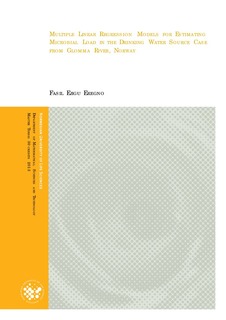Multiple linear regression models for estimating microbial load in a drinking water source case from the Glomma river, Norway
Master thesis
Permanent lenke
http://hdl.handle.net/11250/189167Utgivelsesdato
2014-02-18Metadata
Vis full innførselSamlinger
- Master's theses (RealTek) [1722]
Sammendrag
The application of integrated study of water quality and statistics for environmental modelling
is considered as a powerful analytical tool that has been thrived significantly during recent
years. The present study was conducted to identify the significant physico-chemical factors
that affects the raw water quality, and to study statistical interrelationships amongst them.
Multiple linear regression models were developed to estimate microbial load in the raw water
source, using data from the NRV drinking water treatment plant published from 1999 to 2012
and also from Norwegian school of veterinary science through VISK project. The study was
conducted based on indicator microbial load which contain Total viable count "Kimtall",
Coliform bacteria, Escherichia coli, Clostridium perfringens, and Intestinal Enterococci. In
addition, microbial pathogen load of Noro virus, and Adeno virus were also incorporated. The
explanatory variables examined for regression analysis were monitored properties of raw
water and hyro-climatic data from the catchment which include; river discharge, raw water
temperature, rainfall, pH, turbidity, conductivity, colour, and total organic carbon. Each
indicator and pathogenic microbial loads have its own unique set of selected explanatory
variables. The statistical significance tests were applied to the coefficients of the multiple
linear regression models, and they are found to be significant. The regression equations were
evaluated using measures of variability, including adjusted R2, which ranges from 38.0 % for
Adeno virus concentration to 50.0 % for Ecoli concentration. The results revealed that the
regression analysis provide useful mean for rapid monitoring of microbial raw water quality
based on the physico-chemical parameters.
Beskrivelse
Linear regression model is used to relate the physico-chemical parameters with microbial load of drinking water source
